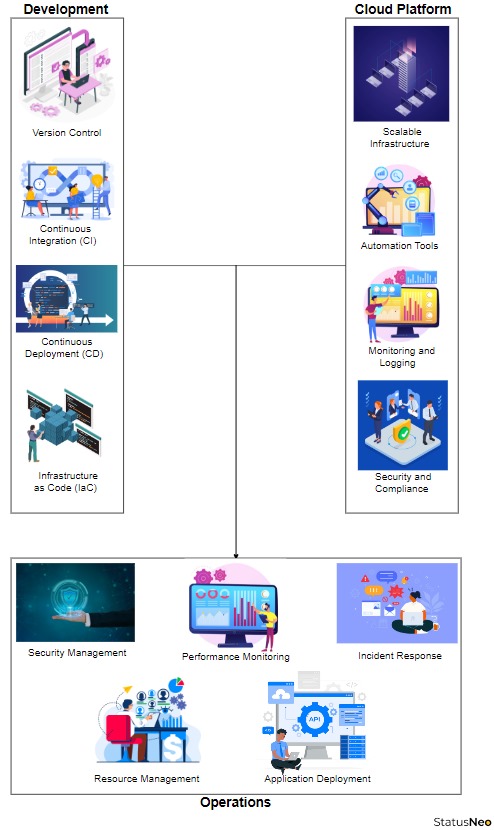DevOps in the Cloud- Streamlining Development and Operations
In the landscape of modern software development, agility, and efficiency are paramount. The rise of cloud computing has revolutionized the way applications are built, deployed, and managed. In this blog post, we’ll delve into the realm of DevOps, exploring how it intersects with cloud computing to streamline development and operations, fostering collaboration, automation, and continuous delivery.

Understanding DevOps
DevOps represents a significant shift in how software development and IT operations are approached, emphasizing both cultural and technical aspects to achieve faster and more efficient software delivery. Let’s delve deeper into these concepts concerning the earlier discussion:
Cultural Transformation: DevOps is not just about implementing new tools and processes; it’s about fostering a cultural shift within organizations. Traditionally, development (Dev) and operations (Ops) teams have operated in separate silos, with limited communication and collaboration between them. DevOps seeks to break down these silos and promote a culture of collaboration, communication and shared responsibility. By encouraging developers and operations teams to work together closely throughout the software development lifecycle, DevOps fosters a sense of ownership and accountability for the entire process.
Technical Practices
Automation: Automation lies at the heart of DevOps. Enabling teams to automate manual, repetitive tasks across the software delivery pipeline. This includes automating build processes, testing procedures, deployment workflows, and infrastructure provisioning. By automating these tasks, teams can reduce errors; increase consistency, and accelerate the delivery of software updates.
Continuous Integration (CI): Continuous Integration involves regularly merging code changes from multiple developers into a shared repository, followed by automated build and testing processes. CI ensures that code changes are integrated and validated continuously, helping detect and address integration issues early in the development cycle. This promotes collaboration and reduces the risk of introducing bugs or regressions into the codebase.
Continuous Delivery (CD): Continuous Delivery extends the principles of CI by automating the deployment process; allowing teams to release software updates to production rapidly and reliably. CD involves automating deployment pipelines to move code changes through various environments (e.g., development, staging, production) with minimal manual intervention. This enables teams to deliver new features and enhancements to end-users quickly and consistently.
Infrastructure as Code (IaC): Infrastructure as Code involves managing and provisioning infrastructure resources using code-based definitions. With IaC, infrastructure configurations are codified and version-controlled, allowing teams to treat infrastructure as software and apply software development practices such as versioning, testing, and code reviews. This enables teams to automate the provisioning and management of infrastructure, ensuring consistency and repeatability across environments.
Enabling Innovation and Value Delivery: By embracing DevOps principles and practices, teams can focus less on manual, repetitive tasks and more on innovation and delivering value to end-users. Automation frees up time and resources, allowing developers and operations teams to concentrate on developing new features, optimizing performance, and addressing customer needs. This results in faster time-to-market, improved product quality, and enhanced customer satisfaction.

The Role of Cloud Computing
Cloud computing plays an important role in enabling modern DevOps practices, serving as the foundational infrastructure that empowers teams to streamline development and operations processes. Here’s a delve into how cloud computing aligns with DevOps principles:
- Scalability: Cloud platforms offer unparalleled scalability, allowing organizations to scale their resources up or down based on task. This means that during periods of high traffic or increased workload, developers and operations teams can provision additional resources to ensure optimal performance and availability. Conversely, during quieter periods, resources can be scaled back to minimize costs and avoid overprovisioning. This dynamic scalability enables teams to handle varying workloads efficiently.
- Elasticity: In addition to scalability, cloud computing provides elasticity, which enables resources to be provisioned and released dynamically in response to changing requirements. This elasticity allows teams to adapt quickly to fluctuations in demands, without the risk of underutilizing infrastructure or being constrained by capacity limits. Whether scaling up to meet sudden spikes in traffic or scaling down to accommodate decreased usage, the ability to dynamically adjust resource allocation ensures that organizations can maintain agility.
- Automation: Cloud providers offer a wealth of automation capabilities because of robust APIs and services. These automation tools enable teams to automate various aspects of their infrastructure, including provision, configuration management, and deployment workflow. By automating routine tasks and workflows, organizations can significantly reduce manual overhead, minimize human error, and accelerate the delivery of software updates and changes. Automation is the heart of DevOps, enabling teams to achieve greater efficiency, consistency, and reliability.
- Pay-as-you-go Pricing: One of the key advantages of cloud computing is the pay-as-you-go pricing model, which aligns closely with DevOps principles of cost optimization and resource efficiency. Cloud services typically charge organizations based on actual usage, allowing them to pay only for the resources they consume. This eliminates the need for large upfront investments in hardware infrastructure and enables organizations to scale their costs in line with their usage patterns. By leveraging pay-as-you-go pricing, organizations can optimize their cloud spending and maximize cost savings.
DevOps Practices in the Cloud
- Infrastructure as Code (IaC): Infrastructure as Code (IaC) plays an important role in DevOps, allowing teams to define and manage infrastructure using code. In the cloud, platforms such as AWS, Azure, and Google Cloud offer tools like AWS CloudFormation, Azure Resource Manager, and Google Cloud Deployment Manager to help with automation. By codifying infrastructure constructions in code, teams can control these definitions, ensuring consistency across different environments. This assists them in replicating easily, rolling back whenever needed, and deploying updates quickly.
- Continuous Integration and Continuous Delivery (CI/CD): CI/CD pipelines automatize the process of building, testing, and deploying applications, allowing teams to frequently and reliably update software. In the cloud, services like AWS Code Pipeline, Azure DevOps, and Google Cloud Build support CI/CD workflows. CI/CD pipelines coordinate with version control systems like Git, automatically starting the building process, tests, and deployments whenever updates are pushed to the repository. This automation verifies code changes constantly, decreasing the risk of integration problems and accelerating the delivery of new features.
- Monitoring and Logging: Observing and logging are vital in DevOps practices, offering real-time insights into application performance and user experience. Cloud-native monitoring solutions like AWS CloudWatch, Azure Monitor, and Google Cloud Monitoring provide extensive monitoring capabilities suited to cloud environments. These tools allow teams to examine metrics, logs, and traces throughout their cloud infrastructure, enabling the identification and troubleshooting of issues proactively. Setting up alerts and notifications helps teams react quickly to incidents, ensuring optimal performance and availability of applications.
- Collaboration and Communication: DevOps emphasizes collaboration and communication among developing, operations, and other stakeholders to foster a culture of shared ownership and accountability. In the cloud, collaboration is facilitated by tools like Slack, Microsoft Teams, and Google Workspace, which provide real-time communication, document sharing, and collaboration features. These collaboration platforms enable teams to collaborate effectively across distributed environments, share knowledge and best practices, and coordinate tasks and activities.
- Security and Compliance: Security is a top priority in DevOps, especially in cloud environments where data breaches and compliance requirements are significant concerns. Cloud providers offer a wide range of security services and compliance certifications to help organizations protect their assets and meet regulatory requirements. DevSecOps practices integrate security into every stage of the software development lifecycle, leveraging tools like AWS Identity and Access Management (IAM), Azure Security Center, and Google Cloud Security Command Center.
To sum it up
DevOps and cloud computing are symbiotic forces driving innovation and agility in the software industry. By embracing DevOps practices and leveraging the scalability and automation capabilities of the cloud, organizations can accelerate the delivery of high-quality software, reduce time-to-market, and enhance collaboration and efficiency across teams. As technology continues to evolve, DevOps in the cloud will remain at the forefront of software development, empowering organizations to adapt and thrive in an increasingly competitive landscape.
Here is the link to my previous blog- Snowflake vs. Data Warehouse: Clash of Innovation








